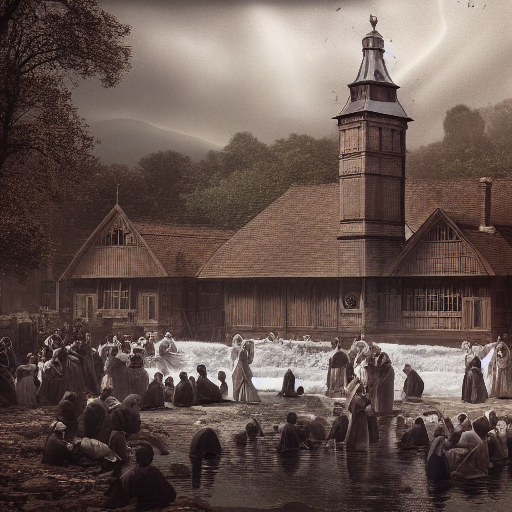By William H. Benson
The Parallel Lives
Of The NOBLE AMERICAN RELIGIOUS THINKERS AND BELIEVERS:
Roger Williams VS. Cotton Mathers
NEW ARTICLES

Jonathan Winthrop’s ‘A Model of Christian Charity’
Jonathan Winthrop’s ‘A Model of Christian Charity’
In recent days, I have begun reading John Barry’s book, “Roger Williams and the Creation of the American Soul: Church, State, and the Birth of Liberty.”
Although published in 2012, Barry tells the story of how the Puritans chose to leave old England to build a plantation on the rocky New England coast of Massachusetts.
In England, the Puritans wanted to purify and simplify their church. Hence, the title of Puritans. They wanted a rustic sanctuary, without stained glass windows and gaudy artwork. Also, they wanted the Anglican clerics to dress without cassock, cap, or gown.
King James I, his son Charles I, and Charles’s archbishop William Laud disagreed. Laud and his henchmen hunted the Puritans down, jailed them, and even tortured them. For these Puritans, exile to North American represented a better choice.
The Puritans formed a corporation, the Massachusetts Bay Company, for the purpose of planning for and constructing a plantation in New England.
On March 4, 1629, King Charles granted the company a royal charter. That same summer the company sent an advance party of five ships carrying 350 settlers to Salem.
In October of 1629, the Massachusetts Bay Company’s stockholders voted to elect Jonathan Winthrop as the corporation’s governor. He fixed a future date of March 1, 1630, for his and his one thousand fellow Puritans’ departure from England.
The planning was monumental. Barry wrote, “It was an immense task, suffocating in detail.” Winthrop hired a fleet of eleven ships, including his ship, the “Arabela.”
Winthrop ordered “14,700 brown biscuits, 5300 white biscuits, 30 hogsheads of beef, 6 hogsheads of pork, 200 tongues; a number of kettles, pans, ladles, ploughs, hoes, and seeds; plus cattle, horses, dogs, goats, pigs, sheep; muskets, pikes, drums, and colors.”
“Everything England society had, New England needed.”
About March 1, people began arriving in Southampton, a port city. Most planned to sail to America, but friends and family members showed up to bid them good-bye. They knew that once they boarded a ship, they may not return, and never see England again.
To this host of people, in mid-March, first the Reverend John Cotton preached on 2 Samuel 7:10, and then nearly the same day, Governor Jonathon Winthrop delivered a sermon that he entitled, “A Modell of Christian Charitie.”
Winthrop insisted that the Puritans love one another. To them, he said, “We must delight in each other, make others’ conditions our own, rejoice together, mourn together, labor and suffer together.” He expected them to practice justice and mercy.
But Winthrop’s most often quoted phrase contained the words, “for we must consider that we shall be as a city upon a hill; the eyes of all people are upon us.”
On January 9, 1961, President-elect John F. Kennedy said, “I have been guided by the standard John Winthrop set before his shipmates on the flagship ‘Arabela’ 351 years ago, as they, too, faced the task of building a new government on a perilous frontier.”
On November 3, 1980, before the election, Ronald Reagan said, “I have quoted John Winthrop’s words more than once on the campaign trail, for I believe that Americans in 1980 see that vision of a shining city on a hill, as did those long-ago settlers.”
In 2006, Barack Obama mentioned Winthrop’s speech in a commencement address.
In 1999, the “New York Times Magazine” asked Peter J. Gomes, a Harvard preacher, to select the best sermon of the previous millennium, and he chose Winthrop’s sermon.
Gomes called it “the most enduring metaphor of the American experience, that of the exemplary nation called to virtue and mutual support.”
Some would agree that America represents the best that the world offers, and that others watch us and follow our lead. Right or wrong, Winthrop’s sermon created an ideal that Americans ever since have tried to practice.
JAMES FENIMORE COOPER VS. AGATHA CHRISTIE
JAMES FENIMORE COOPER VS. AGATHA CHRISTIEJAMES FENIMORE COOPER VS. AGATHA CHRISTIE by William H. Benson September 15, 2010 Born on this day, September 15, in 1789 was the American author James Fenimore Cooper. Because he inherited his father's vast...
THE CRUSADES
THE CRUSADESTHE CRUSADES by William H. Benson September 2, 2010 Soldiers from western Europe invaded Palestine, that narrow strip of land along the eastern coast of the Mediterranean Sea with the intention of establishing a Western colony there. These warriors...
COMPETENCY VS. CREATIVITY
COMPETENCY VS. CREATIVITYCOMPETENCY VS. CREATIVITY by William H. Benson August 19, 2010 This past weekend I read in The New York Times Magazine of an online board game called “Bring It,” in which players draw from a deck of cards a series of math questions....
HUGO CHAVEZ VS. SIMON BOLIVAR
HUGO CHAVEZ VS. SIMON BOLIVARHUGO CHAVEZ VS. SIMON BOLIVAR by William H. Benson August 5, 2010 Across my desk last week came an interesting quote: “The unreal is more powerful than the real, because nothing is as perfect as you can imagine it, because it’s only...
DON KNOTTS
DON KNOTTSDON KNOTTS by William H. Benson July 22, 2010 Jesse Don Knotts was born on July 21, 1924 in Morgantown, West Virginia into a truly dysfunctional family. The last of four sons, Don slept in the kitchen so that his mother could rent out his room to...
THE OTHER WES MOORE
THE OTHER WES MOORETHE OTHER WES MOORE by William H. Benson July 8, 2010 A book review in the Denver Post last week caught my attention. It told of a book written by a banker named Wes Moore and was entitled The Other Wes Moore. In it, Moore recounts the details...
Older Posts
MIDSUMMER DAY FESTIVAL
MIDSUMMER DAY FESTIVALMIDSUMMER DAY FESTIVAL by William H. Benson June 24, 2010 For fun this summer, I read the first of Stieg Larsson’s three mystery novels, The Girl With the Dragon Tattoo. In it, Larsson, a Swedish author, tells the story of a missing person,...
A STATISTICAL ANOMALY
A STATISTICAL ANOMALYA STATISTICAL ANOMALY by William H. Benson June 10, 2010 Vikas Swarup of India published his debut novel, Q & A, in 2005. Told in first person, the story is that of Ram Mohammad Thomas, an eighteen-year-old waiter who survived a multitude...
MEMORIES
MEMORIESMEMORIES by William H. Benson May 27, 2010 “Precious Memories, how they linger,” sings the Gospel singer. Ralph Waldo Emerson, born on May 25, in 1803, hinted at those “lingering” memories, seemingly jointly held: “There is one mind common to...
JANE FRANKLIN MECOM
JANE FRANKLIN MECOMJANE FRANKLIN MECOM by William H. Benson May 13, 2010 Benjamin Franklin’s father, Josiah Franklin, was married four times, and by two of those wives, he produced seventeen children: Elizabeth, Samuel, Hannah, Josiah, Anne, Joseph I, and...
EVIDENCE
EVIDENCEEVIDENCE by William H. Benson April 29, 2010 An English word that has drifted out of common usage is the word “pseudodox,” meaning a false idea or untrue opinion, but perhaps it is time to bring the word back. Today, April 29, 2010, marks the...
CRITICISM
CRITICISMCRITICISM by William H. Benson April 15, 2010 Another prize-winning author once said of William Faulkner: “Well, he never faced any criticism,” a statement that I find odd, even inexplicable, for it seems to me that in America for at least the past three...

One of University of Northern Colorado’s 2020 Honored Alumni
William H. Benson
Local has provided scholarships for history students for 15 years
A Sterling resident is among five alumni selected to be recognized this year by the University of Northern Colorado. Bill Benson is one of college’s 2020 Honored Alumni.
Each year UNC honors alumni in recognition for their outstanding contributions to the college, their profession and their community. This year’s honorees were to be recognized at an awards ceremony on March 27, but due to the COVID-19 outbreak that event has been cancelled. Instead UNC will recognize the honorees in the fall during homecoming Oct. 10 and 11……
Newspaper Columns
The Duodecimal System
For centuries, the ancient Romans calculated sums with their clunky numerals: I, V, X, L, C, D, and M; or one, five, ten, 50, 100, 500, and 1,000. They knew nothing better.
The Thirteenth Amendment
On Jan. 1, 1863, President Abraham Lincoln signed the Emancipation Proclamation, and by it, he declared that “all persons held as slaves” within the rebellious states “are and henceforward shall be free.” Lincoln’s Proclamation freed some 3.1 million slaves within the Confederacy.
The Fourteenth Amendment
After Congress and enough states ratified the thirteenth amendment that terminated slavery, Congress passed the Civil Rights Act of 1866. This law declared that “all people born in the United States are entitled to be citizens, without regard to race, color, or previous condition of slavery or involuntary servitude.” The Act equated birth to citizenship.
The New-York Packet and the Constitution
Jill Lepore, the Harvard historian, published her newest book a month ago, These Truths: A History of the United States. In a short introduction, she describes in detail the Oct. 30, 1787 edition of a semi-weekly newspaper, The New-York Packet.
Mr. Benson’s writings on the U.S. Constitution are a great addition to the South Platte Sentinel. Its inspiring to see the history of the highest laws of this country passed on to others.
– Richard Hogan
Mr. Benson, I cannot thank you enough for this scholarship. As a first-generation college student, the prospect of finding a way to afford college is a very daunting one. Thanks to your generous donation, my dream of attending UNC and continuing my success here is far more achievable
– Cedric Sage Nixon
Donec bibendum tortor non vestibulum dapibus. Cras id tempor risus. Curabitur eu dui pellentesque, pharetra purus viverra.
– Extra Times
FUTURE BOOKS
- Thomas Paine vs. George Whitefield
- Ralph Waldo Emerson vs. Joseph Smith
- William James vs. Mary Baker Eddy
- Mark Twain vs. Billy Graham
- Henry Louis Mencken vs. Jim Bakker






